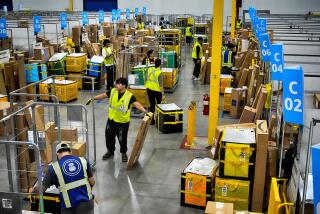First-Quarter Productivity Up Nearly 1%, U.S. Finds
- Share via
WASHINGTON — Americans increased their efficiency in producing goods and services at an annual rate of nearly 1% last quarter, the government said Monday in one of three reports showing a robust U.S. economy.
Non-farm businesses improved their productivity by an annual rate of 0.9% from January through March, reversing a 1% deterioration in their efficiency during the previous three months, the Labor Department said.
Excluding agriculture and government, those businesses responsible for three-fourths of the nation’s economic activity raised their output of goods and services by 2.7% with only a 1.7% increase in hours worked.
Meanwhile, the Commerce Department said orders for U.S. manufactured products increased 1.6% in March while construction spending rose by 1.5%, much of it on government building and highway projects.
“Everything is coming up roses,” said Allen Sinai of the Boston Co., a New York-based economic consultant. “A little trouble on the inflation front and in the financial markets is not a strong price to pay for this kind of super performance on growth, jobs and spending. It’s an incumbent politician’s dream.”
The increase in factory orders to a seasonally adjusted $216.08 billion in March after no change in February and a decrease in January was seen as coming from both domestic and foreign markets.
While an export boom has been occuring for several months, analysts had seen little in trade figures to indicate that the devaluation of the dollar had made imports expensive enough to curb Americans’ appetites for them.
“These orders show that domestic auto and clothing makers are starting to displace the tide of imports,” said Lawrence Chimerine, president of the WEFA Group, formerly Wharton Econometrics, in Bala Cynwyd, Pa. “There’s still no booming demand in consumer spending.”
The rise in construction spending was led by a 5.4% surge in government projects, some of the result of Congress overriding President Reagan’s veto of an $88 billion highway bill last year.
The productivity gains were a surprise to most economists in the wake of employment reports showing the creation of nearly 1 million new jobs the first three months of 1988.
“The economy is not quite as strong as the employment data suggest,” said Donald Straszheim, chief economist for Merrill Lynch. “In fact the productivity numbers look pretty good.”
They showed wages and benefits increased at an annual rate of 3.4% in the first quarter, raising the labor costs associated with each service or product by 2.4% annually.
But those unit labor costs had soared at an annual rate of 4.5% in the final quarter of 1987, triggering fears among several analysts that the nation was on the verge of wage-push inflation.
“Productivity is the cushion you can put in between wage increases and price increases; this is good news for inflation,” said David Wyss, an economist for Data Resources Inc. of Lexington, Mass.
After taking inflation into account--as measured by relative changes in total output and prices--the wage gains the first quarter of 1988 yielded not a penny more of purchasing power for workers. Still, it is the first time since the last quarter of 1986 that they have even kept pace with inflation.
Manufacturing, which still accounts for about one-fourth of the country’s gross national product, continued to lead the effort in restoring U.S. competitiveness.
Productivity by manufacturers increased at an annual rate of 2.9% the first quarter with a 4.3% increase in output on only a 1.3% increase in the number of hours worked in the nation’s factories.
For the first time since early 1986, factory workers actually kept ahead of inflation, according to the data.
More to Read
Inside the business of entertainment
The Wide Shot brings you news, analysis and insights on everything from streaming wars to production — and what it all means for the future.
You may occasionally receive promotional content from the Los Angeles Times.








